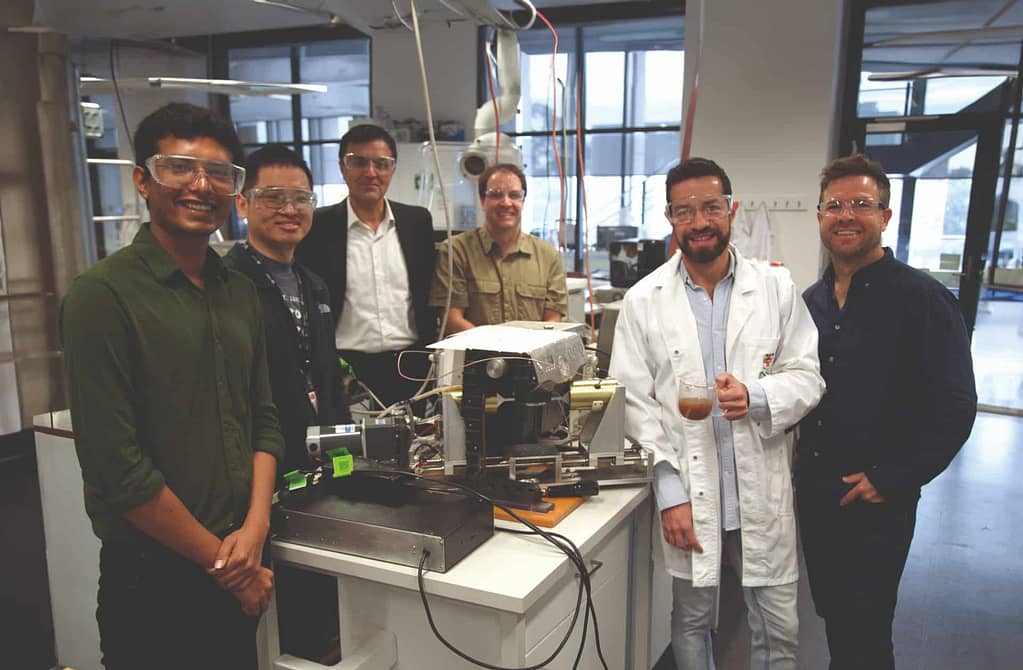[[{“value”:”Image: University of New South Wales
Scientists at University of New South Wales have discovered a new method of brewing coffee that could make ‘ultrasonic’ waves in the industry.
It might sound like something straight out of a sci-fi movie but according to Dr Francisco Trujillo, Senior Lecturer at the School of Chemical Engineering at University of New South Wales, Australia, blasting coffee with ultrasonic waves might be the key to extracting a broader range of flavours and textures compared to other brewing methods.
“Ultrasonic waves accelerate the extraction process due to acoustic cavitation,” he explains.
“When acoustic bubbles collapse near the ground coffee, they generate micro-jets [of liquid] with enough force to pit and fracture the grounds – intensifying the extraction of the aroma and flavours.”
Trujillo subjects coffee to these ultrasonic waves via an adapted espresso machine. The process of preparing the coffee is nothing out of the ordinary to start. It is ground and placed in the portafilter basket, then connected to the machine. Normal enough.
The next step is where the science happens. A transducer-horn assembly is levered into place and the brewing process starts with a five second infusion. The transducer horn then begins injecting ultrasonic waves into the filter basket, which starts to resonate ultrasonically. The process takes around two minutes.
According to Trujillo’s research, this setup can double the extraction yield and caffeine concentration, and increase the extraction of coffee oils eightfold. The result is a unique concoction: an opaque, caramel coloured, highly viscous coffee, brewed at an ambient temperature, instead of the higher temperature usually required to extract espresso.
“The magic of the ultrasonic coffee is revealed with brew ratios of around 2 to 2.5, producing a rich, flavourful coffee similar to espresso, but with a remarkably clean finish. The ultrasonic coffee displays a fantastic fruit and floral acidity, like that of filter coffee, but potentiated due to its higher concentration of dissolved solids,” he says.
Trujillo and team believe this method has the potential to revolutionise ambient brewing, offering a unique result which combines desirable characteristics from both filter and espresso coffee.
Like many famous inventions, ultrasonic coffee was an accidental discovery for Trujillo and his team of researchers.
In 2019, Trujillo was collaborating with entrepreneur Craig Hiron to find a way to raise the level of antioxidants in a cup of coffee. He subjected ground coffee to ultrasonic waves using a large and expensive semi-industrial ultrasonic unit, but found no discernible differences in the levels of antioxidants. What he did discover, however, was that the resulting coffee had superior flavour and texture.
“I wasn’t able to mask my excitement at the discovery. I shouted: ‘Look at this colour, look at this flavour, look at this creaminess,” Hiron says.
The unexpected but promising results encouraged Trujillo to research the relationship between coffee and ultrasonic waves. After some initial prototyping, and several ups and downs, he began working with Professor Kourosh Kalantar-Zadeh, current lead of the School of Chemical and Biomolecular Engineering at the University of Sydney, to simplify the technology and process.
While his first experimental espresso machine was almost too large to fit on a table, his latest prototype is much more compact and convenient.
Trujillo says there is still much to explore: for instance, he has used blends and single origins with similar roast profiles thus far, preferring to keep variables narrow. Even within these parameters the flavours reflected from each coffee are wildly different using this process.
The next step is bringing his invention out of the lab and into the world. The plan is to commercialise and license the ultrasonic coffee brewing technology with major coffee machine manufacturers, with a provisional patent already in place.
He acknowledges ultrasonic coffee machines will be slightly more costly than traditional models, although he insists it remains “commercially viable”, as his research has already demonstrated it can be adapted to an existing espresso machine with a low-cost investment. Trujillo considers his invention a “blessing from heaven”.
“Imagine how sad it would have been if, after five years of hard work, the coffee ended up being boring. Fortunately, it wasn’t,” he says. “The ultrasonic coffee is rich, bold, and clean, with a fantastic fruitiness, texture, and flavour.”
This article was first published in the July/August 2024 edition of Global Coffee Report. Read more HERE.
The post Is ultrasonic coffee the future of brewing? appeared first on Global Coffee Report.
“}]]


